How to Choose the Right Energy Management Solution in the UAE
For engineers and panel builders in the UAE and GCC, an inefficient facility is a constant financial drain. Hidden energy waste from HVAC systems battling extreme heat or from unoptimized industrial motors directly impacts the bottom line. The solution lies in a robust energy management solution (EMS), a high-tech system designed to monitor, control, and optimize every watt of power your facility consumes.
Why Energy Management Is Critical in the GCC
In a region defined by intense heat and rapid industrial growth, managing energy isn't just about saving a few dirhams—it's a core business strategy for survival and profitability. An energy management solution combines smart hardware and software to provide the real-time data needed to shift from reactive problem-solving to proactive optimization.
The financial and operational benefits are significant. The market for Energy Management Systems (EMS) in the Middle East and Africa is expanding rapidly, driven by industrialisation and a greater focus on sustainability. This growth underscores how essential these solutions have become for controlling energy costs in a demanding climate.
The Core Functions of an Energy Management Solution
A solid energy management solution is built on four key pillars. Each has a specific function, but they work together to create a powerful system for achieving peak efficiency.
- Metering & Data Acquisition: This is the starting point. High-precision energy meters and sensors are installed to accurately measure consumption at critical points—from the main incomer down to individual machines. Without clean, reliable data, the rest of the system is operating blind.
- Monitoring & Visualisation: This function transforms raw data into actionable intelligence. The software uses dashboards to display real-time usage, historical trends, and consumption patterns, giving you a clear view of where and when your energy is being used.
- Control & Automation: This is where you act on the insights. The system can automatically shed non-essential loads during peak hours, optimize HVAC settings based on occupancy, or adjust motor run times, all without manual intervention.
- Analytics & Reporting: This is the brain of the operation. The analytics tools identify anomalies, forecast future energy demand, and generate detailed reports. These reports are invaluable for justifying new investments and proving compliance with regional standards.
For facility managers and engineers, this means finally pinpointing underperforming equipment that secretly drains power. For procurement teams, it provides the hard data needed to justify investing in high-efficiency electrical components UAE that deliver a clear, measurable return.
While our focus here is on commercial and industrial applications, the principles of efficiency are universal. Exploring key energy efficient home design strategies provides a broader perspective, showing how smart energy use is a core component of modern building and facility management—a principle GoSwitchgear champions across every sector in Dubai and the GCC.
Exploring the Building Blocks of a Modern EMS
To assemble an effective energy management solution, engineers and panel builders must understand its core components. Think of it as a high-performance toolkit where each tool has a specific job. A successful system harmonizes four critical elements to turn raw electrical data into tangible savings and operational intelligence.
When data flows seamlessly from meters to software and from software to automated controls, a facility transforms from a passive energy consumer into an actively managed, highly efficient operation.
Metering and Data Acquisition: The Eyes of the System
You can't manage what you can't measure. This is why the foundation of any credible energy management solution is accurate data. High-quality energy meters and sensors act as the vigilant eyes of your electrical network.
These devices are installed at key points—from main incomers to distribution boards and high-consumption equipment like chillers or production lines. The goal is to create a detailed, live map of your energy flow.
Key considerations for selection:
- Accuracy Class: This is non-negotiable. For data you can trust, you need meters with the appropriate accuracy class (e.g., Class 1 or the more precise Class 0.5s under IEC standards).
- Mounting Type: Consider the installation environment. DIN rail-mounted meters are ideal for monitoring sub-circuits inside panels, while panel-mounted meters are suited for main switchboards. GoSwitchgear offers a full range to fit any project in the GCC.
- Communication Protocols: Your meters must communicate with the rest of the system. Ensure they support standard protocols like Modbus or BACnet for seamless integration.
Monitoring and Visualisation: Turning Data into Intelligence
With a steady stream of data from your energy meters, the next step is to make sense of it. This is the role of monitoring and visualisation software, often part of a larger Building Energy Management System (BEMS) or a SCADA platform.
This software acts as your central command hub, pulling in data and presenting it on intuitive dashboards, charts, and real-time graphs. Abstract numbers become clear, actionable patterns. You can spot peak demand times, identify unusual consumption on a single circuit, and compare energy use across different facilities.
A BEMS doesn't just display data; it provides context. By integrating with systems like HVAC and lighting, it helps you understand not just how much energy is used, but why—unlocking the door to smart, targeted optimizations.
Automated Control Systems: The Hands That Take Action
Insights are valuable only when acted upon. The control component of an energy management solution Dubai provides the "hands" to implement changes based on real-time data. This is where automation delivers measurable savings.
Control systems can range from simple timers to complex PLC-driven logic. As you explore these elements, consider how advanced tools like BIM solutions can create a digital twin of a building, offering even deeper data for energy analysis.
Common control strategies include:
- Load Shedding: Automatically deactivating non-essential loads (e.g., water heaters, secondary AC units) during peak electricity price periods.
- HVAC Optimisation: Adjusting temperature setpoints and fan speeds based on real-time occupancy and weather data.
- Lighting Control: Using sensors and schedules to ensure lights are only active when and where they are needed.
Analytics and Reporting: The Brain of the Operation
The analytics and reporting engine is the system's brain. While monitoring software shows what’s happening now, analytics reveals what it means and what to do next. It processes historical data using intelligent algorithms to perform advanced functions.
This includes flagging consumption anomalies that might indicate equipment failure, forecasting future energy demand, and generating detailed reports for management and regulatory bodies. These reports are crucial for proving your return on investment and making a case for future efficiency upgrades.
For a closer look at how IoT and cloud technologies are enhancing these analytics, read our guide on modern energy management solutions in the UAE.
Selecting Hardware That Survives the GCC Climate
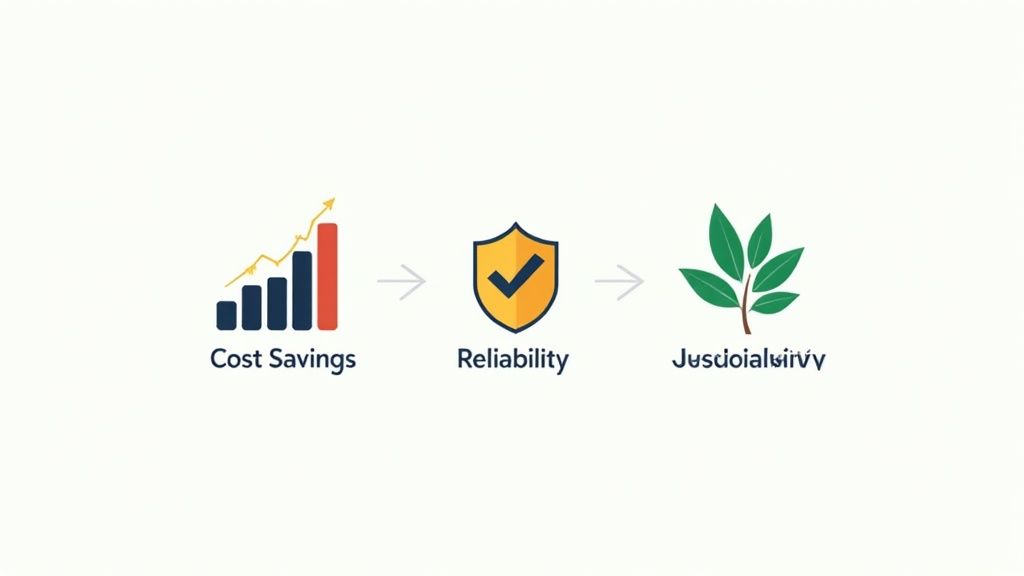
Choosing electrical components for a project in the UAE or KSA isn't just about meeting technical specifications; it's about ensuring survival. For panel builders, electricians, and procurement teams, selecting hardware that withstands extreme heat, high humidity, and fine dust is critical for long-term reliability.
The wrong choice leads to premature equipment failure, unexpected downtime, and costly replacements. A component that performs flawlessly in a mild European climate can quickly degrade in the ambient temperatures and airborne sand of Dubai or Riyadh. Understanding environmental protection and heat management is essential for the success of any energy management solution.
Decoding IP Ratings for GCC Environments
The first line of defense for any electrical component is its enclosure. The IP (Ingress Protection) rating, an IEC standard, tells you how well the enclosure protects internal electronics from solids (like dust) and liquids (like moisture). For any engineer or electrician in the UAE, this two-digit code is fundamental.
- The First Digit (Solids): This number (0-6) indicates protection against solid objects and dust. In the GCC, a rating of 5 (dust-protected) or, ideally, 6 (dust-tight) is non-negotiable for outdoor equipment or installations in industrial zones.
- The Second Digit (Liquids): This number (0-9) indicates protection against moisture. For most indoor panels, a rating of 4 or 5 is sufficient to handle humidity. However, for outdoor units or wash-down areas, a rating of 5 (protection from water jets) or higher is needed to combat condensation and direct water exposure.
For example, an IP65 rated component is an excellent choice for many tough applications across the UAE and KSA, offering complete dust protection and resistance to low-pressure water jets.
IP Rating and Application Guide for GCC Environments
| IP Rating | Protection Against Solids (First Digit) | Protection Against Liquids (Second Digit) | Typical Application in GCC |
|---|---|---|---|
| IP54 | 5: Dust protected. Limited ingress permitted but not enough to interfere with operation. | 4: Protected against splashing water from any direction. | Indoor control panels, junction boxes in covered areas. |
| IP65 | 6: Dust-tight. No ingress of dust. | 5: Protected against water jets from any direction. | Outdoor electrical panels, equipment in dusty factory floors. |
| IP66 | 6: Dust-tight. | 6: Protected against powerful water jets. | Exposed outdoor equipment, marine applications, wash-down areas. |
| IP67 | 6: Dust-tight. | 7: Protected against temporary immersion in water (up to 1m for 30 mins). | Underground junction boxes, equipment prone to temporary flooding. |
Thermal Management Inside the Panel
A high IP rating keeps dust and water out, but it can also trap heat in. In a region where ambient temperatures can exceed 50°C, managing heat generated by components inside an electrical panel is just as critical as protecting it from the external environment.
Overheating is a silent killer of electrical systems. It shortens the lifespan of sensitive electronics like an SMPS power supply, causes nuisance tripping, and affects the accuracy of energy meters. An effective energy management solution relies on hardware that stays cool enough to perform reliably.
Key strategies for heat management:
- Smart Component Selection: Always specify components with high maximum operating temperature ratings. At GoSwitchgear, we stock products like our SMPS power supply units and DIN rail isolator series specifically for their proven performance in the high ambient temperatures of the GCC.
- Ensure Proper Spacing: A crowded panel is a hot panel. Follow manufacturer guidelines for spacing between heat-producing devices to allow for natural convection.
- Implement Ventilation: Use correctly sized ventilation louvres with filters or forced ventilation with panel fans for enclosures with high heat loads.
- Neat Wiring: Use properly sized, high-temperature-rated cables and manage them neatly to avoid obstructing airflow.
By focusing on both external protection (IP ratings) and internal thermal health, engineers and panel builders in Dubai can build systems that are not just efficient but exceptionally durable, securing the energy management solution GCC investment for years.
Your Step-by-Step Implementation Roadmap
Implementing an effective energy management solution is a structured process. For facility managers and engineers in the UAE, a clear roadmap transforms a complex project into manageable steps, ensuring every component, from an energy meter GCC to the central software, delivers maximum value.
This roadmap guides you from initial discovery to final optimization, setting a clear path to enhanced efficiency and cost control.
Phase 1: The Foundational Energy Audit
Begin with a deep dive into your current energy usage. An energy audit establishes your baseline and identifies the most significant opportunities for savings.
- Identify Major Loads: Pinpoint energy-intensive equipment—chillers, large motors, pumps, and HVAC systems.
- Map Electrical Distribution: Trace your electrical network to determine strategic locations for installing energy meters to capture the most valuable data.
- Analyse Utility Bills: Review at least 12-24 months of DEWA, SEWA, or ADDC bills to identify peak demand charges and seasonal consumption patterns.
The data from this audit builds the business case and guides the design of your energy management solution.
Phase 2: System Design and Component Selection
With audit data in hand, you can design a system that addresses your facility's unique challenges.
- Develop a Metering Strategy: Decide which specific circuits and equipment require dedicated monitoring.
- Specify Control Hardware: Select robust components like relays, contactors, and a DIN rail isolator to ensure safe and reliable control of electrical loads.
- Choose the Right Software: Evaluate BEMS or SCADA platforms to find one that meets your monitoring and analytics needs.
A thoughtful design ensures your system is scalable and can adapt to future efficiency goals, preventing costly rework later. This flow from data collection to optimization is a continuous loop, as illustrated below.
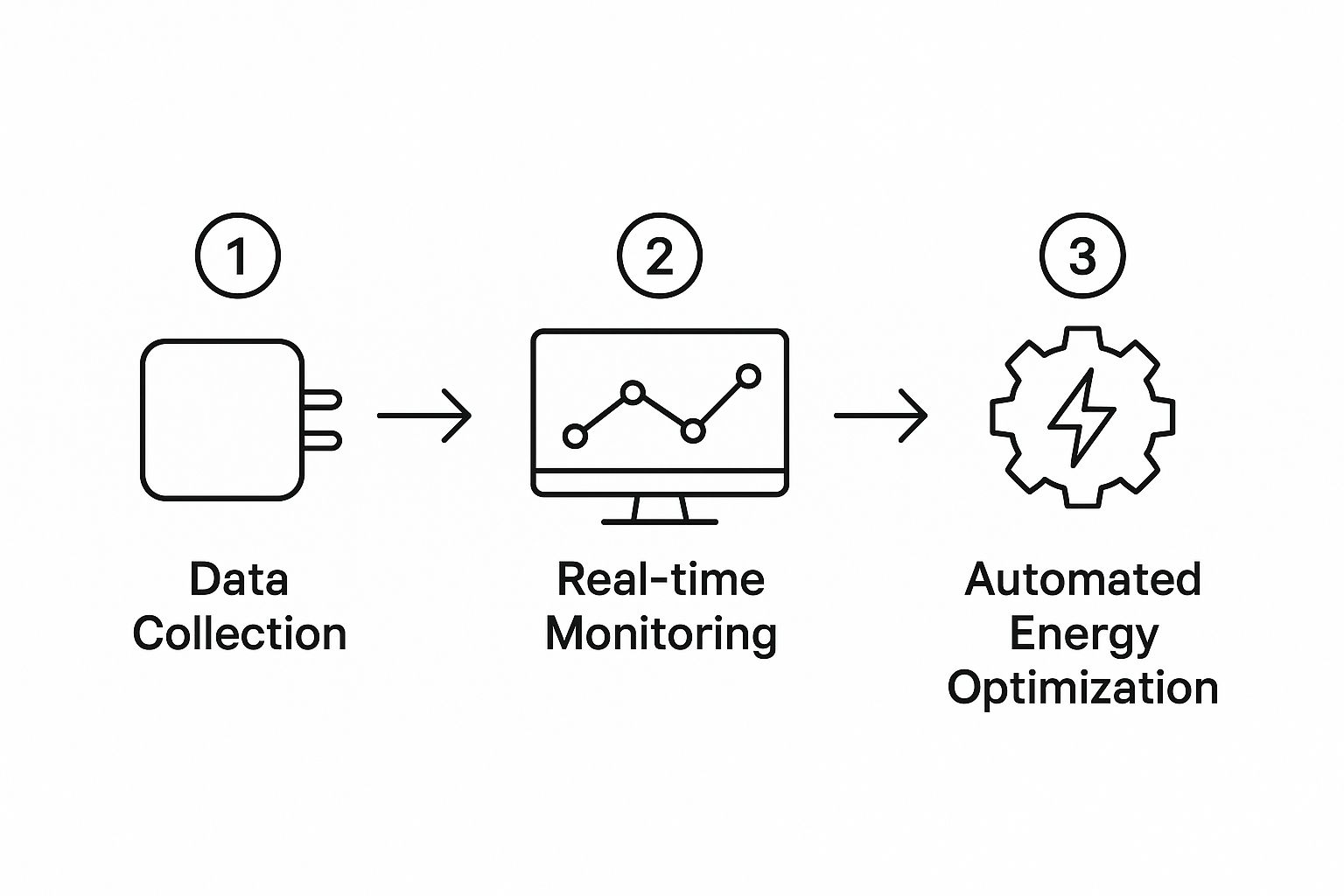
This visual captures the essence of a modern EMS: smart automation driven by precise, real-time data.
Phase 3: Installation and Integration
This is where the plan comes to life. Precision and adherence to local regulations are paramount for electricians and installation teams.
A common and costly mistake is the incorrect installation of Current Transformers (CTs). If a CT is installed backwards or on the wrong phase, all data from that meter becomes useless, undermining the entire monitoring effort.
Best practices for installation:
- Adhere to Local Utility Regulations: All work must comply with standards from authorities like DEWA.
- Proper Component Wiring: Methodically wire all control circuits and communication cables (e.g., Modbus) connecting meters to the central system.
- Integrate with Existing Systems: Carefully connect the new EMS with any existing BMS or automation systems to create a seamless operation.
Phase 4: Commissioning and Fine-Tuning
Once installed, the system goes live. Commissioning involves testing every component to ensure it functions as designed. This is not just flipping a switch; it's about meticulous fine-tuning to maximize your return on investment.
- Verify Data Accuracy: Cross-check meter readings against utility bills to confirm accuracy.
- Configure Alarms: Set up alerts for abnormal consumption or equipment malfunctions.
- Optimise Control Strategies: Fine-tune load-shedding schedules and HVAC setpoints to achieve maximum energy savings without disrupting operations.
For those considering renewables, this step-by-step guide to solar panel installation offers practical advice.
Real-World Success Stories Across the UAE
Technical specifications are one thing, but seeing an energy management solution deliver tangible results is what proves its value. Across the UAE, businesses are turning these systems into major operational and financial advantages.
Industrial Plants in JAFZA and KIZAD
For facilities in demanding environments like Jebel Ali Free Zone (JAFZA) or Khalifa Industrial Zone Abu Dhabi (KIZAD), energy is a massive operational cost. A smart energy management solution GCC is essential for profitability.
Key strategies include:
- Motor Performance Optimisation: By fitting precise energy meters to large motors, maintenance teams gain real-time insights into load profiles and efficiency, enabling predictive maintenance that prevents costly failures.
- Avoiding Peak Demand Penalties: An EMS automates load shedding, cycling off non-critical equipment to stay below penalty thresholds, saving thousands of dirhams monthly.
- Predictive Maintenance: Monitoring the energy signature of critical machines allows engineers to detect anomalies that signal impending failure, transforming maintenance from reactive to proactive.
Commercial Towers and Malls in Dubai
Dubai's iconic skyscrapers and malls face a complex energy puzzle with vast HVAC and lighting loads. A Building Energy Management System (BEMS) is a necessity.
A well-implemented BEMS is the central brain of a building, orchestrating thousands of data points to balance energy savings and occupant comfort. Real-world examples from downtown Dubai show a BEMS can slash energy bills by 15-30%.
They achieve this through:
- Smarter HVAC Control: The system adjusts chiller outputs and air handling unit (AHU) speeds based on live temperature and occupancy data, eliminating wasted energy cooling empty spaces.
- Intelligent Lighting: Lighting is integrated with schedules and daylight harvesting sensors, dimming lights automatically when natural light is sufficient and switching them off in unoccupied rooms.
Residential Communities and Smart Homes
Efficiency is also becoming a priority in homes. Home Energy Management Systems (HEMS) are gaining popularity in villas and apartment buildings, giving homeowners control over their consumption and DEWA or ADDC bills.
The HEMS market in the Middle East and Africa, valued at USD 82.5 million in 2024, is projected to grow at a CAGR of 13.9% through 2031, signaling strong consumer adoption. You can review the complete market analysis and future trends for more details.
These systems empower residents to:
- Track Real-Time Usage: User-friendly apps connected to a central energy meter GCC display electricity consumption for AC, water heaters, and other appliances.
- Set Smart Schedules: Homeowners can schedule high-consumption appliances to run during off-peak hours, directly reducing their utility bills.
In every scenario, the success of an energy management solution depends on the quality of its electrical components UAE. GoSwitchgear provides the dependable meters, isolators, and power supplies that ensure these systems operate flawlessly, turning data into measurable savings.
Answering Your Key EMS Questions
Implementing an energy management solution raises practical questions for engineers, facility managers, and procurement teams across the UAE and GCC. Getting clear answers is essential for making a sound investment. This section addresses the most common questions we hear at GoSwitchgear.
What Is the Typical ROI for an Energy Management Solution?
This is the primary question: what’s the return on investment (ROI)? A well-designed energy management solution is a profit driver, not a cost center. In our experience across the UAE and KSA, the payback period for a comprehensive EMS project is typically between 1 to 3 years.
This timeline depends on:
- Local Utility Tariffs: Higher electricity rates and peak demand charges from providers like DEWA, SEWA, and ADDC accelerate savings and shorten the ROI.
- Project Scope: Focusing on high-consumption areas like industrial motors or commercial chillers yields a faster payback.
- Operational Hours: A 24/7 facility has more opportunities to save energy, leading to a quicker return.
The initial investment in quality hardware, including accurate energy meters, is quickly offset by significant reductions in monthly utility bills.
Can I Retrofit an EMS Into an Existing Building?
Yes. Most EMS installations are retrofits in existing buildings. Modern electrical components UAE are designed for this scenario, allowing for smooth integration without a complete infrastructure overhaul.
However, retrofitting requires careful planning:
- Panel Accessibility: Ensure clear, safe access to main switchboards and sub-distribution panels for installing energy meters and control wiring.
- Integration with Existing Systems: The new EMS must communicate with any existing BMS or automation hardware. Using components that support common protocols like Modbus is essential.
- Space for New Components: Verify there is enough physical space on DIN rails or inside panels for new gear like an SMPS power supply or protection circuits.
A thorough site survey during the audit phase will identify potential retrofitting challenges early on.
Should I Install a Full BEMS or Start with Basic Metering?
This is a strategic decision with no one-size-fits-all answer. While a full-scale Building Energy Management System (BEMS) offers powerful control, it is a significant upfront investment. For many organizations in Dubai and Abu Dhabi, a phased approach is the smartest strategy.
Starting with a solid monitoring system built around high-quality energy meters GCC allows you to first understand your consumption patterns. This data helps identify "low-hanging fruit" for savings and builds a strong business case to justify a future investment in a full control system.
This phased strategy allows you to:
- Establish a Baseline: Gather hard data on where and when energy is used.
- Identify Immediate Savings: Uncover energy waste that can be fixed with simple operational changes.
- Justify Further Investment: Use real savings data to secure the budget for a full BEMS.
- Design a Smarter Control System: Base your future control strategy on real-world data, not assumptions.
To learn more about the fundamentals, explore our guide on everything you need to know about energy management.
How Does an EMS Support Our ESG Goals?
An energy management solution is a cornerstone of any credible Environmental, Social, and Governance (ESG) strategy. It provides the precise, verifiable data needed for accurate sustainability reporting and demonstrating a commitment to environmental stewardship.
The detailed data collected is critical for:
- Accurate Carbon Footprint Calculation: You cannot manage carbon emissions without accurately measuring energy consumption.
- Regulatory Compliance: The system generates reports needed to comply with regional environmental regulations and green building standards.
- Demonstrating Stewardship: Sharing data-backed reports on energy reduction shows investors, customers, and the community that your company is serious about sustainability.
An EMS transforms sustainability from a vague goal into a measurable, data-driven initiative, positioning your organization as a responsible leader in the region.
Ready to build a smarter, more efficient energy management system for your projects in Dubai or Abu Dhabi? The expert team at GoSwitchgear is here to help you select the right electrical components and provide the technical support you need. Reach our Dubai team for project support or request a quote for your Abu Dhabi projects.
Browse Our Full Range of Energy Management Components at GoSwitchgear



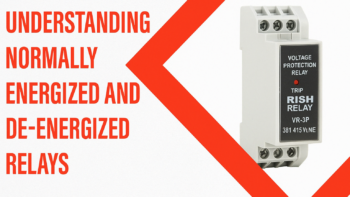

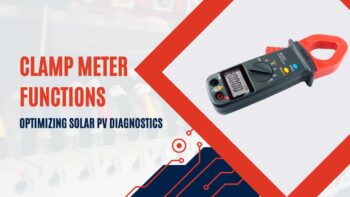


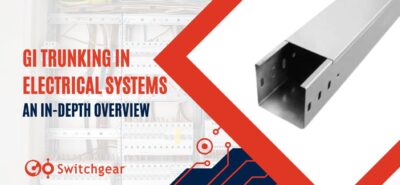

Leave a Reply